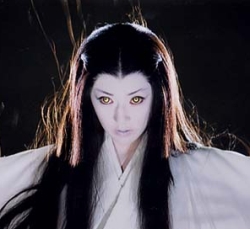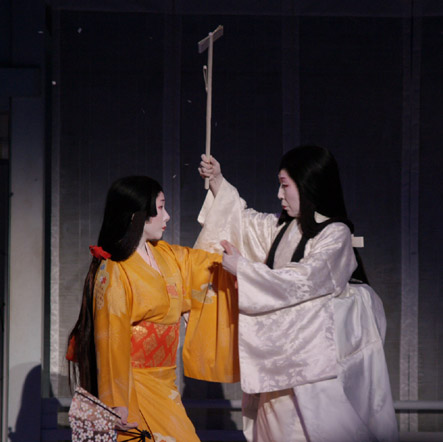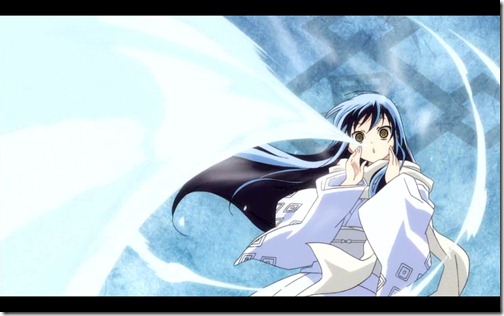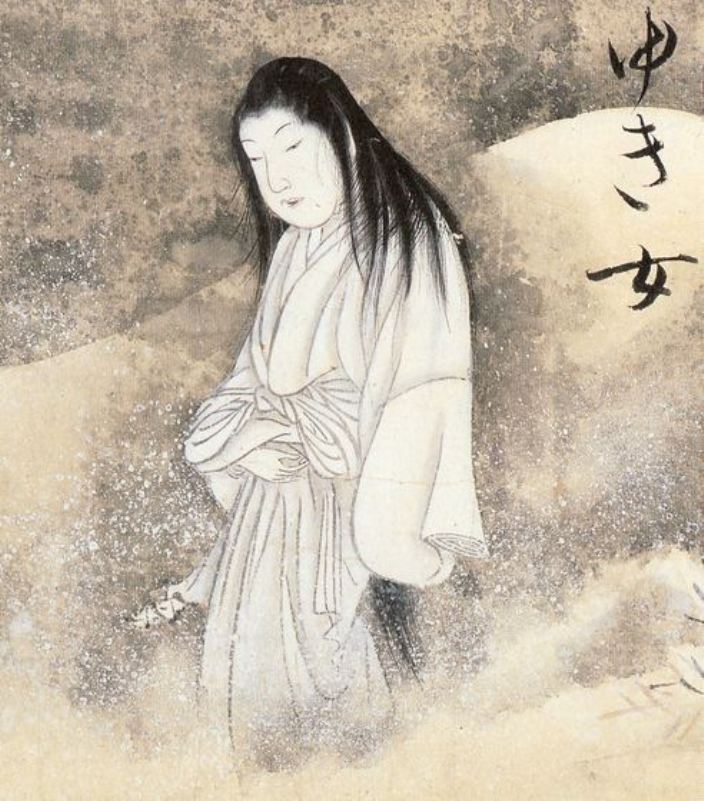Yuki-Onna: the Snow Woman of Japan
SPOILER ALERT
The following article will tell you all about Yuki-Onna, but not in the form of the original stories. If you would like to read the original stories first, then click on this link -- The Original Legends -- and come back later to read the history of the stories since their publication!

Yuki-Onna from the movie Kwaidan (1964)... [Picture source here]
Yuki-Onna [雪女], whose name literally means “snow woman,” is a legendary being in Japan that is believed to appear only during snowy weather; and the more stormy the weather, the more she's expected to be out in it. Tales tell how she hunts for humans to freeze to death; but they also tell of how she fell in love with a handsome young man, and became human to be his wife... until he betrayed her trust.

Here she is in a geisha play from 2006... [Larger version here]

...and from a Japanese TV series in 2010. [Larger version here]
Yuki-Onna is so well-known in Japan that she has become a stock character in television, movies, novels, comics, plays, and games, a ghostly snow-white figure immediately recognized by both the young and the old. Her story is referenced so much in modern Japan that the snow woman has made my list of the Six Japanese Monsters anyone interested in Japanese culture needs to know about. The fame of Yuki-Onna in Japan is especially interesting because it is entirely due to the efforts of an European traveler and writer that lived in Japan at the turn of the 20th century!
The "Discovery" of Yuki-Onna
The oddly named Lafcadio Hearn [1850-1904] was a traveling journalist, born in Greece to an Irish father and Greek mother. Hearn was already well-known for newspaper editorials and reports written while he lived in Cincinatti and New Orleans in the United States before he first traveled to Japan. In 1890 he took a teaching position in Japan, and found the country so to his liking that he soon married the daughter of a samurai, and accepted Japanese citizenship in 1896 (as well as a Japanese name - Koizumi Yakumo), which is also when he moved to a teaching position at the University of Tokyo. Hearn became the interpretor of Japan and its customs to the English-speaking world as he started to produce book after book on various topics of Japanese life and history. Hearn had learned the Japanese language well enough to read tales in old manuscripts when he could find them, and to converse with his Japanese friends about the tales and legends they grew up with... and all of these became the stuff of his books. More remarkable still, like the Brothers Grimm did in Germany, Hearn was sometimes the first person to record these older tales in writing, which made his books of interest to native Japanese as well as foreigners.
The tale of Yuki-Onna was one of those unique legends. It is now acknowledged that Hearn was the first person known to present the tale of Yuki-Onna in writing... and he got it straight from the storyteller's mouth. Hearn stated in the introduction of his book Kwaidan: Stories and Studies of Strange Things [1904] that the story of Yuki-Onna, which is presented in said book, was told to him by a farmer of Chofu, Nishitama-gori, in Musashi Province. Chofu is now a city in the western end of the Tokyo Metropolis... so Yuki-Onna may have once walked where modern Tokyo now exists. The farmer told the tale as a legend of his village, but Hearn never stated whether the farmer actually believed the tale to be true.
To summarize Hearn's tale of Yuki-Onna briefly, it tells how an older man, Mosaku, and a younger man, Minokichi, left their village one winter's day to gather firewood, only to be caught out when a storm started. They took shelter in a small hut and soon fell asleep. Minokichi awoke suddenly in the night to discover the hut's door open, and a ghostly white woman -- both beautiful and terrifying -- leaning over Mosaku and gently breathing white mist over him. When she turned to Minokichi, he immediately feared for his life... but the strange woman offered to spare him if he swore to never tell anyone what he had seen that night. Not surprisingly, he made the vow; and the strange woman left the hut fading into the storm outside. Minokichi turned to Mosaku, and found his friend frozen to death.
Minokichi kept his word for years after that strange night and told no one, not even his beloved wife who he married about a year after the incident. They lived a simple and happy life, raising their ten children... but the memory of that hideous night always haunted him. One evening, as the children slept and his wife sat quietly mending some clothes, he was suddenly struck by how much his wife looked like that strange woman of many years ago as the fire light flickered across her features. Without thinking he started to tell her about the night, and how much she reminded him of it at the moment, and she set aside her sewing and listened patiently... and when he finished the story, his wife rose, now completely snow-white and enraged, and told him the only reason she wouldn't kill him immediately was for the sake of the children. Warning him strongly to never give them reason to complain, she drifted out into the night and disappeared into the falling snow forever.
When Kwaidan was published in Japanese, the tale of Yuki-Onna was absolutely loved by the new generation of urban Japanese who had little of their ancestors' experience with living in wild terrain. The tale -- and later, the movies based on Kwaidan that included Yuki-Onna -- proved so popular that everyone in Japan came to know who the character of Yuki-Onna was.
A Japanese Sense of the Snow-Woman
While the story of Yuki-Onna as presented by Lafcadio Hearn was all new to his English-speaking audience, the overall structure of the story was very familiar to his Japanese audience.
The idea of a wife who is supernatural and must hide this secret or leave is a repeating story motif throughout Japan. The reasons a supernatural creature becomes a man's wife varies, as does her reaction upon discovery, but in all cases the wife must leave once the secret is stated; it's clear in some versions of this story that the husband knows of his wife's unusual nature, but she only leaves when he reveals this fact aloud. I've seen many variations, from transformed animals such as a cow wife or a shark wife, or even monsters such as 'Futa-Kuchi Onna' [二口女]... the man-eating 'Woman with Two Mouths' who actually tries to eat her husband when her secret is revealed! Yuki-Onna's tale is just another of these stories, and not even the best known at that; the tale of the Grateful Crane is a much older and better known story in this genre (and another must-know for anyone interested in Japan! Click Here).
The tale of Yuki-Onna seems to have reached it's status in Japan for several reasons that made it stand out. First off, it was presented to Japan by an Europeon author writing in Japanese, which must have been impressive at the time (even if someone else translated). Secondly, Hearn was an excellent storyteller. And last, but certainly not least, due to its popularity at the start of the 20th century, the tale was targeted early on for the Japanese movie industry. Movies made around Yuki-Onna not only further spread the legend, they divorced it from any direct locale in Japan... so Yuki-Onna's tale soon was told as if it could have happened anywhere in the country.
In addition, the range of Yuki-Onna's character in the original story, from murderous monster to loving wife and mother, opened the character to an equally wide range of re-interpretations. This may be a key reason the snow woman has continually appeared as a character within new stories in Japan that use her outside of framework of the original legend; Yuki-Onna, as a character, can be recognized even when she is presented with a different name. Sometimes scary, sometimes misunderstood, sometimes old, sometimes young... yet in each incarnation, still recognizable as an aspect of the same complex character.
But you wouldn't know that if you stuck to purely English sources about Yuki-Onna's legend!
Yuki-Onna and the English Speaking World
Strangely, most of what is printed about the legend of Yuki-Onna in English has very little to do with how her character is actually protrayed, thought of, or utilized in Japan; instead, what is claimed to be true of Yuki-Onna in English are just variants of what was originally published about her in English from the years 1904 to 1913. This may sound surprising, but I've encountered this problem before; people interested in a culture that they can't directly travel or speak to will treat almost anything about that culture printed in a language they understand as if it was the ultimate knowledge available about the topic, even if it's incorrect... and the end results of this "foreignization" can often be a story that natives of the culture would never recognize.
With the popular success of Kwaidan in Europe and America, it wasn't long before other authors were producing collections of Japanese tales and legends... and some were producing what looked like Japanese tales and legends. Two more tales said to be of Yuki-Onna were released in 1908, and one more detail was added in 1913, which changed the idea of the snow woman for the English speaking world.
In 1908, Frederick Hadland Davies published a story called "The Great White Face" in the February issue of the magazine Special Crops; the story was then later included in his book The Land of the Yellow Spring (1910). The story tells of a married man with a wandering eye who is seduced by Yuki-Onna, and nearly killed by her sucking his "life blood" away. He's rescued by the timely arrival of his loyal wife, whom he finally realizes is more important to him than any other female he's ever fancied. I have not yet been able to determine if Davies translated the tale from Japanese or simply made it up himself but, from the evidence of the time, the story doesn't seem to have made an impact on the legend of Yuki-Onna... that came later.
Also in 1908, Richard Gordon Smith released his book Ancient Tales and Folklore of Japan. In this volume he includes a tale of a ghost that asks for shelter from a snowstorm as it is traveling to a village to chastise it's former husband. Ignoring that it is firmly established in the story that the spirit is that of a young woman who died the year previously in the cold of winter, and that the spirit needs shelter from a snowstorm, Smith opens and closes his tale with the following statements:
"Perhaps there are not many, even in Japan, who have heard of the 'Yuki Onna' (Snow Ghost). It is little spoken of except in the higher mountains, which are continually snowclad in the winter. Those who have read Lafcadio Hearn's books will remember a story of the Yuki Onna, made much of on account of its beautiful telling, but in reality not better than the following."
...
"That is roughly my story of the Yuki Onna. All those who die by the snow and cold become spirits of snow, appearing when there is snow; just as the spirits of those who are drowned in the sea only appear in stormy seas."
In short, Smith stated that "Yuki-Onna" was not the name of an individual being, but rather a collective title for the spirits of women who die in the snow; this assumption on his part seems to be tied to the mis-translation of "Yuki-Onna" to the phrase "snow ghost," rather than the correct translation of "snow woman." Smith's tale itself was in fact from Japan, collected by him while he traveled through the country collecting specimens and historic information for the British Museum. The snow ghost tale was translated for him by a person named Yuki Egawa; but whether Smith or Egawa mis-translated the term Yuki-Onna is anyone's guess.
The final sculpting of the English version of the Yuki-Onna legend came in 1913 and at the hands of the afore-mentioned Frederick Hadland Davis. In that year he published Myths and Legends of Japan which he intended to be an all-inclusive collection of the various ancient tales that had been published in English from Japan. Unlike Davis' previous book in 1910, this collection of tales became very popular and therefore what it summed up about the legend of Yuki-Onna in Japan -- whether correct or not -- soon became the summary that was repeated by other authors in America and Europe who were not going to go as far as Japan to find out more.
Being a single volume, Davis was naturally brief in the presentation of most of the stories he included... none the less, Yuki-Onna got a whole chapter to herself in the book. This chapter included mostly brief summaries of both Lafcadio Hearn's telling of the Yuki-Onna tale, and Richard Gordon Smith's tale of the snow-ghost... but Davis also added two notable additions to the legend. First off, he reinterprets Smith's statement above of what happens to people who die in the snow in Japan:
"According to Mr. R. Gordon Smith, in his Ancient Tales and Folk-lore of Japan, 'all those who die by the snow and cold become spirits of snow.' That is to say, all those who perish in this way become identified with Yuki-Onna, the Lady of the Snow."
... which is not true. Yuki-Onna in Japan is considered to be a separate being from mere ghosts.
Secondly, though Davis doesn't repeat his story of "The Great White Face" that he presented in 1908 -- which, as noted, may have been his own creation rather than an actual tale from Japan -- he once again asserted the idea that Yuki-Onna was vampiric in nature:
"The ideal snow-scene is to be found in Japan, and because it is so particularly beautiful it is surprising to find that Yuki-Onna, the Lady of the Snow, is very far from being a benevolent and attractive spirit. All the artistry and poetry of snow vanish in her malignant presence, for she represents Death, with attributes not unlike that of a vampire.
...
There is no promise of spring in the long white form of Yuki-Onna, for her mouth is the mouth of Death, and her ice-cold lips draw forth the life-blood of her unfortunate victims."
... and this time, because of the popularity of the book and it's implied authority for the sheer range of tales it collected, Davis' interpretations of Yuki-Onna as both a vampire and as the expected fate of those who die in the snow -- neither idea of which is held in Japan -- has become accepted parts of the description of Yuki-Onna repeatedly published in America and Europe ever since.
The Unknown History of Yuki-Onna
The strangest thing about both the Japanese and English versions of the Yuki-Onna legend above is that anyone who does even a little research quickly discovers one thing: even though everyone now remembers only what was written about Yuki-Onna in 1904 and beyond, it's perfectly clear that some form of her legend was being told in Japan as early as 1737.

Fig. 1 from 'Bakemono Zukushi' [Larger version here]

Fig. 2 from 'Hyakki Zukan' [Larger version here]

Fig. 3 from 'Gazu Hyakki Yagyou' [Larger version here]
This is because of an illustration by the Japanese artist Sawaki Suushi (佐脇嵩之) [Fig. 2 above], created in 1737 for his scroll Hyakkai-Zukan (百怪図巻, "The Illustrated Volume of a Hundred Demons"). This scroll is a collection of illustrations of monsters well-known in literature, folklore, and other people's art. The illustration we are concerned with is of a ghostly female in the snow, and is clearly labeled as Yuki-Onna... which shows that at least the same basic elements that are associated with Yuki-Onna now -- white kimono and skin, long black untied hair, and snow -- were also associated with her then. In addition, Suushi's illustration appears to be a copy of an even earlier (but undated) illustration by an unknown artist in a scroll called the Bakemono Zukushi which is also labeled as Yuki-Onna [Fig. 1 above]; so some form of Yuki-Onna's legend was almost certainly known before 1737.
An equally important illustration of Yuki-Onna was presented in 1776 by Seikien Toriyama in his book series, Gazu Hyakki Yagyou [Fig. 3 above]. Again she is presented as a ghostly female in a white kimono and associated with a snow scene, and again the illustration is clearly labeled "Yuki-Onna"; more telling still, this label is all there is. In the first two volumes of this series of books, Toriyama was illustrating monsters and spirits that were already well known among his audience... but as the demand for more volumes led him to find stories of creatures further and further away, he started to include short paragraphs in later volumes for each monster, to explain something about these lessor known beings to his audience. So the fact that Yuki-Onna appears in just the second volume, and has no paragraph explaining who she is, all implies that Toriyama's audience already knew the story of Yuki-Onna well enough that he didn't need to explain anything.
An important textual clue was also presented by Lafcadio Hearn in his 1905 book, The Romance of the Milky Way, which was released after his death. In this volume he presents a small selection of poems about Japanese monsters he gleaned from a book he found in shop. This book, Kyoka Hyakku Monogatari, was published in 1853, and contained poems by Ota Nampo that were created as parodies of a then popular poetry style called 'Waka,' and all of the poems in the volume, done in the style called 'Kyoka', were about known monsters as a parody of the usually very serious topics treated in the Waka poems. A whole section of the poems in the book are about Yuki-Onna, again proving her legend existed well before Lafcadio Hearn recorded it... but there is also more that is implied by one of the poems' contents:
Yuki-Onna
Mité wa yasashiku,
Matsu wo ori
Nama-daké hishigu
Chikara ari-keri!
[Though the Snow-Woman appears to sight slender and gentle, yet, to snap the pine-trees asunder and to crush the live bamboos, she must have had strength.]
So perhaps the tales of yuki-Onna we've lost also included her demonstrating such a strength!
There is one more important thing that can be gleaned from all of this semi-forgotten lore about the snow woman. The illustrations by Sawaki Suushi and Sekien Toriyama, as well as the book Kyoka Hyakku Monogatari, were all produced in Edo... which is now called Tokyo, and which is the same area that Hearn collected his version of the Yuki-Onna legend in 1904. So Yuki-Onna is very much a Tokyo based legend, even though it has now been adopted by all of Japan, and it's very clear that stories about her were being told at least 170 years before Lafcadio Hearn wrote her story down.
And it's possible that somewhere, in an old Japanese text, an unknown version of her tale could still be discovered someday.






